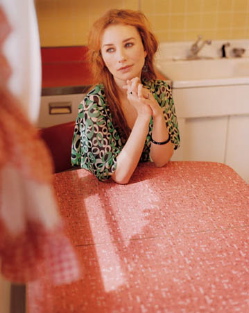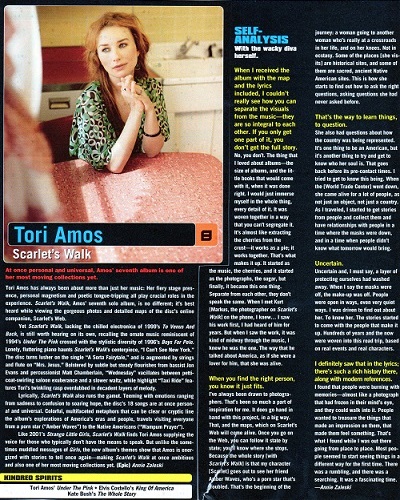|

songs | interviews | photos | tours | boots | press releases | timeline
Alternative Press (US)
November 2002

Tori Amos
Scarlet's Walk
At once personal and universal, Amos' seventh album is one of her most moving collections yet.
by Annie Zaleski
Tori Amos has always been about more than just her music: Her fiery stage presence, personal magnetism and poetic tongue-tripping all play crucial roles in the experience. Scarlet's Walk, Amos' seventh solo album, is no different; it's best heard while viewing the gorgeous photos and detailed maps on the disc's online companion, Scarlet's Web.
Yet Scarlet's Walk, lacking the chilled electronica of 1999's To Venus and Back, is still worth hearing on its own, recalling the ornate music reminiscent of 1994's Under the Pink crossed with the stylistic diversity of 1996's Boys for Pele. Lonely, fluttering piano haunts Scarlet's Walk's centerpiece, "I Can't See New York." The disc turns lusher on the single "A Sorta Fairytale," and is augmented by strings and flute on "Mrs. Jesus." Bolstered by subtle but steady flourishes from bassist Jon Evans and percussionist Matt Chamberlain, "Wednesday" vacillates between petticoat-swirling saloon exuberance and a slower waltz, while highlight "Taxi Ride" features Tori's twinkling rasp overdubbed in decadent layers of melody.
Lyrically, Scarlet's Walk also runs the gamut. Teeming with emotions ranging from sadness to confusion to soaring hope, the disc's 18 songs are at once personal and universal. Colorful, multifaceted metaphors that can be clear or cryptic line the album's explorations of America's eras and people, travels visiting everyone from a porn star ("Amber Waves") to the Native Americans ("Wampum Prayer").
Like 2001's Strange Little Girls, Scarlet's Walk finds Tori Amos supplying the voice for those who typically don't have the means to speak. But unlike the sometimes muddled messages of Girls, the new album's themes show that Amos is energized with stories to tell once again -- making Scarlet's Walk at once ambitious and also one of her most moving collections yet.
Kindred Spirits:
Tori's Amos' Under the Pink
Elvis Costello's King of America
Kate Bush's The Whole Story
~ ~ ~
SELF-ANALYSIS
With the wacky diva herself.
AP: When I received the album with the map and the lyrics included, I couldn't really see how you can separate the visuals from the music -- they are so integral to each other. If you only get one part of it, you don't get the full story.
Tori: No, you don't. The thing that I loved about albums -- the size of albums, and the little books that would come with it, when it was done right. I would just immerse myself in the whole thing, every detail of it. It was woven together in a way that you can't segregate it. It's almost like extracting cherries from the crust -- it works as a pie; it works together. That's what makes it up. It started as the music, the cherries, and it started as the photographs, the sugar, but finally, it became this one thing. Separate from each other, they don't speak the same. When I met Kurt [Markus, the photographer on Scarlet's Walk] on the phone, I knew... I saw his work first, I had heard of him for years. But then when I saw the work, it was kind of midway through the music, I knew he was the one. The way that he talked about America, as if she were a lover for him, that she was alive.
AP: When you find the right person, you know it just fits.
Tori: I've always been drawn to photographers. That's been so much a part of inspiration for me. It does go hand in hand with this project, in a big way. That, and the maps, which on Scarlet's Web will come alive. Once you go on the Web, you can follow it state by state; you'll know where she stops. Because the whole story [with Scarlet's Walk] is that my character [Scarlet] goes out to see her friend Amber Waves, who's a porn star that's troubled. That's the beginning of the journey: a woman going to another woman who's really at a crossroads in her life, and on her knees. Not in ecstasy. Some of the place [she visits] are historical sites, and some of them are sacred, ancient Native American sites. This is how she starts to find out how to ask the right questions, asking questions she had never asked before.
AP: That's the way to learn things, to question.
Tori: She also had questions about how the country was being represented. It's one thing to be an American, but it's another thing to try and get to know who her soul is. That goes back before it's pre-contact times. I tried to get to know this being. When the [World Trade Center] went down, she came alive for a lot of people, as not just an object, not just a country. As I traveled, I started to get stories from people and collect them and have relationships with people in a time where the masks were down, and in a time when people didn't know what tomorrow would bring.
AP: Uncertain.
Tori: Uncertain and, I must say, a layer of protecting ourselves had washed away. When I say the masks were off, the make-up was off. People were open in ways, even very quiet ways. I was driven to find out about her. To know her. The stories started to come with the people that make it up. Hundreds of years and the now were woven into this road trip, based on real events and real characters.
AP: I definitely saw that in the lyrics; there's such a rich history there, along with modern references.
Tori: I found that people were burning with memories -- almost like a photograph that had frozen in their mind's eye, and they could walk into it. People wanted to treasure the things that made an impression on them, that made them feel something. That's what I found while I was out there going from place to place. Most people seemed to start seeing things in a different way for the first time. There was a rumbling, and there was a searching. It was a fascinating time.
original article

[scan by Sakre Heinze]
[transcribed by Michelle Gatton]
t o r i p h o r i a
tori amos digital archive
yessaid.com
|